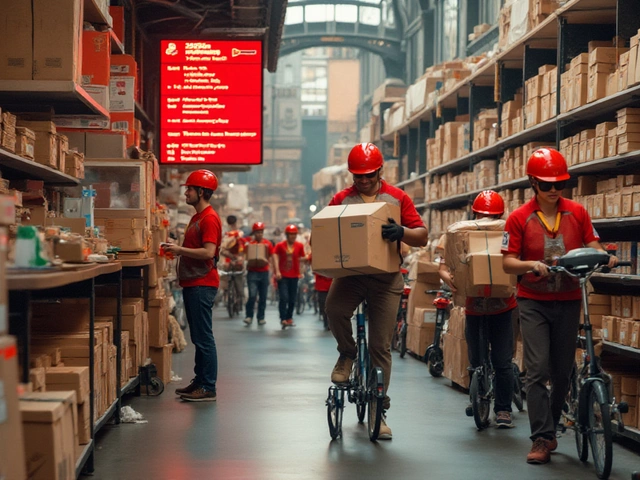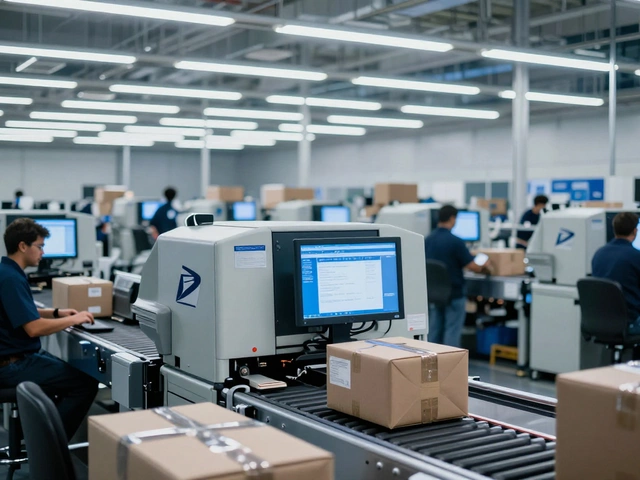In a world where instant gratification is just a click away, next day shipping has become more than a mere convenience—it's an expectation. The minute you press that 'confirm order' button, you start imagining the package at your doorstep. However, there's a crucial piece of the puzzle that ensures this seamless transition from cart to home: the shipping cut-off time.
Shipping cut-off times are like the final boarding calls at an airport. They determine the latest time you can place an order for it to be processed and shipped the same day. This means knowing the precise time when a retailer transfers your order to a courier can make or break your next day delivery dreams. But why do these cut-off times vary so significantly?
Much depends on the retailer’s processes, the courier’s schedules, and even the day of the week. Different carriers have their own cut-off timings, which can further complicate things. A late Thursday order might mean a weekend delivery or even a Monday surprise. Whether you're shopping for urgent gifts or essential supplies, every second counts.
Navigating the intricate workings of next day delivery can seem daunting, but armed with the right knowledge, you can set your expectations accordingly and avoid any disappointments. This piece will guide you through understanding cut-off times, examining carrier differences, and offer tips to keep your shopping spree on track—no matter the day!
- The Importance of Shipping Cut-Off Times
- Factors Influencing Cut-Off Times
- Differences Among Major Carriers
- Tips for Meeting Cut-Off Deadlines
- Special Considerations for Holidays and Remote Areas
The Importance of Shipping Cut-Off Times
In the realm of next day shipping, few elements hold more sway over the experience than the ever-critical cut-off times. These times symbolize the final checkpoint before your order sets out on its journey. The cut-off time is not merely a procedural milestone; it’s a strategic decision point that impacts when products leave the warehouse and when they appear at your doorstep. For retailers and consumers alike, timing is of the essence. An understanding of cut-off times can distinguish between a satisfactory purchasing experience and a frustrating delay.
Consider the fact that during peak shopping seasons, such as the holidays, about 30% of consumers are inclined to choose retailers that guarantee timely delivery. This statistic highlights why retail giants often emphasize their shipping speed—they know the stakes. Across varying businesses, cut-off times can differ, sometimes scheduled earlier in the day by necessity in response to logistical challenges. Supply chain dynamics play a pivotal role here, as inventories must sync with dispatch schedules to maximize efficiency.
“In today's fast-paced e-commerce environment, shipping speed is not just a luxury but a necessity,” states a logistics expert from a leading e-commerce platform.Notably, the complexity of setting an appropriate cut-off time involves numerous factors: product preparation time, carrier schedules, and the geographical location of both origin and destination. Each decision hinges on optimizing this entire intricate network to meet consumer demands without compromising quality or cost. It’s a delicate dance of coordination. According to a recent study, 60% of retailers have changed their logistics strategies to adapt to consumer expectations of next day shipping.
One might wonder how businesses manage process variability with such precision. The answer lies largely in technological advancements, with systems that track order placements, inventory levels, and transport routes becoming indispensable tools. These technologies bring clarity, allowing businesses to provide real-time updates to customers about their orders. As a customer, understanding these processes can empower you to make more informed purchasing decisions, considering both the cut-off times and the expected shipment timelines.
Given the importance of cut-off times, knowing the operational policies of your regular retailers can be a game changer. If you are making a purchase with a tight deadline, aim to place orders well in advance of the cut-off. This practice not only hedges against unexpected delays but also offers flexibility in case of changes to your order. In today's quick-paced world, having this awareness means customers can balance both urgency and patience.
Finally, businesses that consistently align their cut-off times with advertised policies build trust, leading to repeat patronage and greater customer satisfaction. Understanding, respecting, and strategically interacting with these cut-off times can significantly enhance one's next day delivery experience, ensuring that packages arrive promptly and reliably.
Factors Influencing Cut-Off Times
Understanding the dynamics behind next day shipping cut-off times can shed light on why your expected delivery might sometimes be delayed. Cut-off times aren't arbitrarily set; a myriad of factors influences these crucial deadlines. For instance, the geographical location of a warehouse plays a significant role in deciding when your order must be pushed through for next-day service. Warehouses situated closer to major urban centers might have the privilege of stretching cut-off times compared to those in remote areas or with less accessible routes. Additionally, retailers might align their cut-off times with the schedules of major shipping companies to ensure efficient logistics alignments.
Carriers also factor in their operational efficiencies, which includes everything from the volume of shipments handled simultaneously to the workforce managing them. During peak seasons like Christmas or Black Friday, increased order volumes mean earlier cut-off times for ensuring timely processing. But it's not just about the hustle and bustle of holiday sales; surprisingly, the day of the week can also affect these times. Orders placed on a Friday must often meet an earlier deadline to beat the weekend lull. Similarly, during unpredictable weather conditions, companies might adjust cut-off windows as a precautionary measure. Whether it's a snowstorm in New York or heavy rains in Seattle, the climate can throw a wrench in your package's sleek ride to your doorstep.
Retailer Policies and Agreements
Retailer policies and agreements with logistic partners also shape these timescales. Some businesses have special partnerships that allow later order placements, while others might prioritize shipping to their premium customers, tweaking cut-off times as a perk of loyalty. "Our commitment to rapid delivery is deeply integrated into our strategic partnerships," says a logistics expert from a leading e-commerce platform.Strong relationships with carriers allow flexibility in cut-off times, enabling us to cater to customers' urgent needs more effectively.These agreements often include contingencies for sudden spikes in orders, which also ensures there's little to no disruption in services offered throughout diverse geographic locations.
Technological Advances
Technological advancements in logistics have also been reshaping the landscape of shipping cut-offs. Many retailers now employ smart predictive analytics to forecast demand accurately, which, in turn, enables more dynamic cut-off timings. Automated warehousing with robots can pack and tag items faster than humans, pushing the envelope on deadlines.| Carrier | Average Cut-Off Time |
|---|---|
| Carrier A | 3 PM |
| Carrier B | 2 PM |
| Carrier C | 1 PM |
Ultimately, being aware of these factors can help consumers make more informed decisions when opting for next day shipping. It enables planning and aligns expectations with reality. By keeping a keen eye on these influencing elements, customers can enjoy the benefits of quick deliveries without the sorrows of missed cut-off times or delayed packages. Next time you're racing against the clock for that final click, remember, it's not just about the seconds ticking down but the intricate network of influences making it all possible.

Differences Among Major Carriers
When it comes to next day shipping, not all carriers are created equal. The variances between major shipping companies like FedEx, UPS, and USPS can significantly impact your delivery timing. FedEx is renowned for its express service, with cut-off times often as late as 8:00 PM for certain services. They offer multiple options, with FedEx Standard Overnight promising delivery the next business day by 3 PM to most U.S. addresses and by 8 PM to residences. FedEx Priority Overnight is a notch faster, delivering by 10:30 AM to most areas, and even earlier in office districts.
UPS competes fiercely in the fast shipping arena, with their UPS Next Day Air providing overnight delivery to 50 states and Puerto Rico. Cut-off times vary, but many urban centers allow you to order as late as 6:00 PM and still receive your package the next day. Interestingly, UPS offers money-back guarantees on its express services, a testament to their commitment to punctuality. USPS, on the other hand, through its Priority Mail Express, also guarantees overnight service to most addresses, yet the cut-off times are generally earlier compared to FedEx and UPS, usually by 3 PM.
Each carrier sets their schedules based on logistical capabilities, geographical considerations, and historical data. For instance, a FedEx hub in a densely populated area may have later cut-off times than a rural depot due to more frequent runs and higher package volume. This structure allows them to offer competitive pricing while optimizing efficiency. However, it's not just about competition; it's about complementing customer needs and matching consumer expectations in a digital shopping world where fast delivery is expected.
"Customers today are more informed and have higher expectations for shipping services," explains a logistics expert. "Carriers need to be more adaptable, offering later cut-off times and multiple delivery options to stay competitive."
Additionally, the strategies differ if you consider package size and destination. For example, FedEx typically offers a broader range of options for heavier shipments across international borders, while USPS provides competitive rates for lighter parcels within the U.S. The differences don't end there; they extend to backend systems, customer service channels, and tech integrations. With the evolution of e-commerce, these nuances have become critical, allowing shoppers to make informed decisions to select the best fit for their delivery needs.
Tips for Meeting Cut-Off Deadlines
Meeting shipping deadlines is crucial, especially when aiming for a next day shipping service. Many shoppers find themselves rushing against the clock, particularly when an important date is approaching, or the demand for spontaneity takes over. The trick lies in mastering a few strategic approaches that not only ensure timely order placement but also improve your likelihood of delivery success. First, it’s essential to familiarize yourself with the specific cut-off times set by the vendors you frequently buy from. Every retailer and courier may have nuanced differences. Knowing these particularities saves both time and stress. Consider contacting customer services of the retailer to clarify any ambiguities about these times—such transparency can give you a better edge.
Another key strategy involves planning purchases proactively, especially for unique occasions or peak seasons like holidays. It's no secret that during such periods, logistics networks are under immense pressure. By anticipating your needs early and placing orders well within the known cut-off times, you sidestep potential delivery bottlenecks. Thanks to the digital age, setting reminders on your phone for these deadlines can keep your shopping timely and organized. Also, understanding the transient nature of shipping variables is important; unexpected delays may happen, and being prepared for them counts as wisdom. “Time is not refundable; use it with intention,” says anonymous quote found circulating frequently among productivity circles, a timely reminder of the importance of these practices.
"Time is what we want most, but what we use worst." – William Penn
An often overlooked yet significant approach includes leveraging loyalty programs or premium memberships offered by some retailers. These programs can provide access to exclusive cut-off extensions or guarantee shipment even when demand peaks. For all the ins-and-outs of fast delivery, subscribing to such services could turn out to be a worthwhile investment, especially for regular online shoppers. Additionally, experimenting with different couriers might reveal those that align better with your timing needs. Some couriers boast more flexible or later cut-off times relative to others, presenting a golden opportunity for customers seeking agility in precise delivery.
Consider the influence of precise location data, as delivery cut-off times may vary regionally. In remote areas or smaller towns, you may find earlier cut-off times than in bustling urban centers. Living in metropolitan areas often allows for more leisurely deadlines due to the density of service infrastructures. In contrast, less populated areas may challenge the transit schedules, potentially affecting those cut-off benchmarks. As such, monitoring these locational influences allows more accurate planning. Whether through reading fine prints on a website or verifying via customer feedback, acknowledge these geographical factors early in your shopping journey.
Finally, there's the benefit of employing micro-statistics to gauge patterns around your delivery history. Here is an illustrative example:
| Month | On-Time Deliveries (%) |
|---|---|
| January | 93 |
| February | 95 |
| March | 89 |
From records like these, you can better interpret your own success rate with specific retailers or couriers. Reflecting upon when you typically experience delays versus when the process flows smoothly provides invaluable insights. These actionable insights can refine your decision-making process, ensuring your orders meet those critical cut-off deadlines every time without unnecessary hassle.

Special Considerations for Holidays and Remote Areas
When it comes to next day shipping, holidays and remote areas are two factors that often throw a wrench into the usual process. During holiday seasons, such as Christmas and Black Friday, the surge in online shopping activity can lead to significant delays. Carriers are overwhelmed with the volume of packages, sometimes operating at full capacity and still struggling to meet the demand. A fun fact is that the number of parcels shipped on Cyber Monday in the United States can exceed 50 million. This kind of surge tests the efficiency of even the most well-organized logistics systems. As a result, retailers often set earlier shipping cut-off times, advising customers to place their orders well before the holiday rush. Understanding these dynamics allows you to better plan your shopping strategy during busy seasons, ensuring that gifts arrive on time and stress is kept to a minimum.
"It's not just about meeting customer expectations but exceeding them by planning comprehensively," notes Sam Smith, a leading logistics analyst who has studied holiday shipping trends for over two decades.
Unlike urban centers with multiple shipping routes and extensive logistical support, remote areas pose unique challenges for couriers. The geographical isolation of these regions often means fewer delivery schedules, limited shipping options, and unavoidable delays. If you live in a picturesque mountain town or a quaint seaside village, you've probably experienced the uncertainty of waiting for packages. Delivery services might operate on reduced days or times, which can disrupt the promise of swift deliveries. As a tip, consider checking with local post offices or delivery hubs for specific guidelines and schedules in your area. This way, you'll know exactly when a package could arrive, ensuring you're not left guessing from day to day.
In both cases, special considerations must be made. Holidays necessitate strategic shopping well ahead of deadlines, while remote locations require diligence in understanding local restrictions and schedules. Navigating these complexities requires a proactive approach, but with the right strategies, this challenge can become rewarding and your shipping deadlines can be met efficiently.





